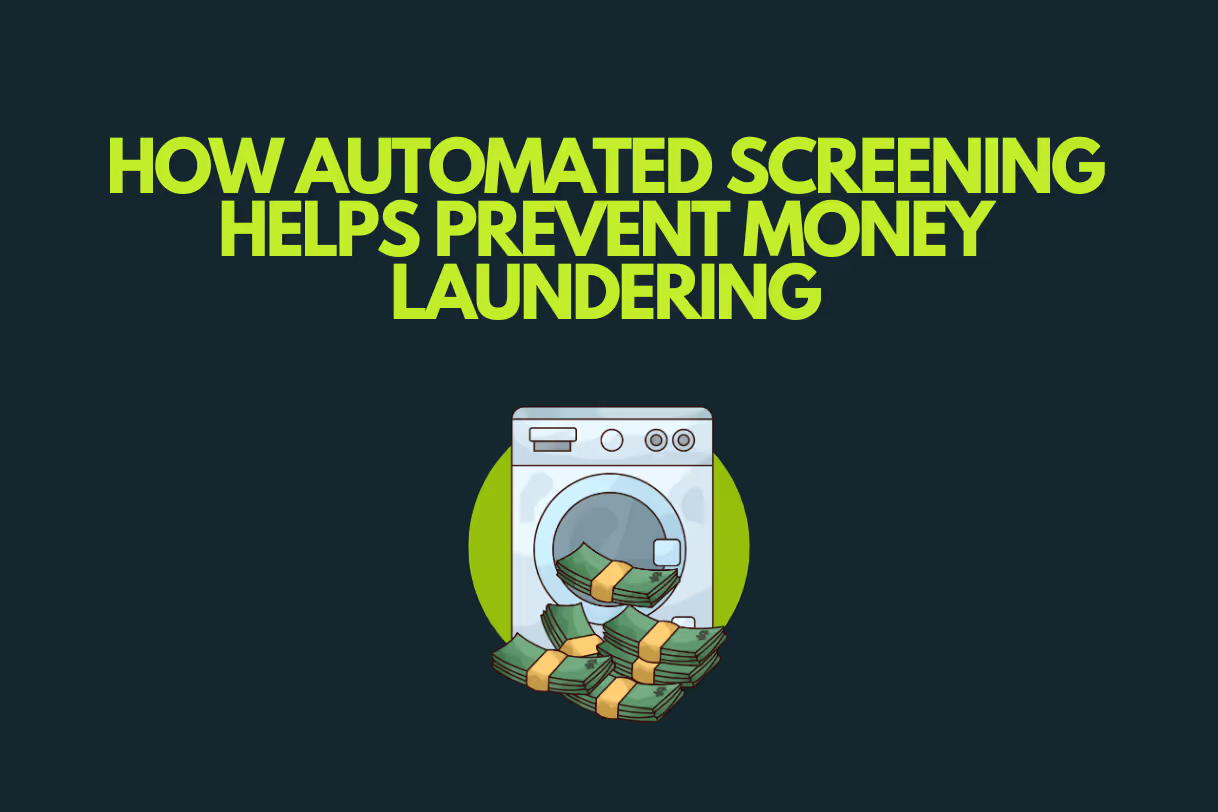
How Automated Screening Helps Prevent Money Laundering
Understand the meaning of money laundering and how automated screening reduces compliance risks. Includes examples and strategies for financial institutions.
Money laundering is not only a financial crime, it’s a direct threat to the integrity of the global financial system. Every year, criminals attempt to disguise billions of dollars in illicit funds, using legitimate financial institutions as cover. For compliance officers, CFOs, and risk managers, the question isn’t whether your firm will encounter attempts—it’s whether your systems are strong enough to detect and prevent them.
That’s where automated screening comes in. By leveraging advanced technology to check customers, transactions, and counterparties in real time, firms can dramatically reduce their exposure to money laundering risks. But before diving into the solution, let’s clarify the money laundering definition, meaning, and real-world examples that shape today’s compliance environment.
Money Laundering Definition
At its core, money laundering is the process of disguising the origins of illicit funds so they appear legitimate. Criminals launder money to integrate “dirty” cash (proceeds of activities like drug trafficking, corruption, fraud, or terrorism) into the financial system without detection.
The official money laundering definition varies slightly across regulators, but most frameworks (including FATF, FinCEN, and the EU’s AML directives) emphasize three key stages:
- Placement - Introducing illicit funds into the financial system (e.g., depositing cash at banks, buying assets).
- Layering - Moving money through complex transactions to obscure its origin (e.g., wire transfers, shell companies, cryptocurrency).
- Integration - Returning “cleaned” money to the economy as apparently legitimate assets or business profits.
Money Laundering Meaning in Practice
While the definition provides a technical understanding, the meaning of money laundering is best understood by looking at how it plays out in real-world scenarios. For example:
Trade-Based Laundering: A company in Country A over-invoices exports to a shell company in Country B. The inflated invoices justify moving large sums across borders, effectively disguising illicit proceeds as trade revenue.
Real Estate Laundering: Criminals buy luxury properties with cash, then later sell them, claiming the proceeds are legitimate profits from real estate investment.
Casino Laundering: Individuals buy casino chips with illicit money, gamble minimally, then cash out. The funds appear as casino winnings rather than criminal proceeds.
These examples highlight why compliance officers can’t rely on intuition or manual checks. Money laundering schemes are sophisticated, evolving, and global.
The Compliance Challenge
Money laundering exposes financial institutions to three major risks:
- Regulatory risk - Non-compliance with AML obligations can result in fines, license revocations, and enforcement actions.
- Operational risk - Manual monitoring creates operational bottlenecks, false positives, and missed red flags.
- Reputational risk - A single headline linking your firm to laundering can erode client trust and investor confidence.
The challenge is scale. With millions of customers, thousands of transactions per second, and constantly shifting regulatory expectations, manual monitoring is no longer viable.
Why Automated Screening Matters
Automated screening is the cornerstone of modern AML compliance. It uses technology to check customers and transactions against sanctions lists, PEP (politically exposed persons) databases, and adverse media sources in real time.
Key benefits:
- Speed - Automated checks run instantly, preventing risky customers or transactions from slipping through.
- Accuracy - Advanced algorithms reduce false positives, allowing teams to focus on genuine risks.
- Coverage - Systems monitor across multiple lists (OFAC, EU, UN, HM Treasury) and data sources simultaneously.
- Scalability - Whether screening 10,000 or 10 million customers, automated solutions scale without adding headcount.
- Auditability - Built-in logs and reports create defensible evidence for regulators and audits.
How Automated Screening Prevents Money Laundering
1. Customer Onboarding
At onboarding, firms must perform KYC checks to verify identity and assess risk. Automated screening ensures:
- Customers are cross-checked against sanctions and watchlists.
- Owners of entities are screened.
- High-risk profiles (e.g., PEPs) are flagged for enhanced due diligence.
This stops known criminals, sanctioned parties, or shell companies from entering the system at the front door.
2. Transaction Monitoring
Money laundering often reveals itself through unusual activity. Automated screening systems can:
- Flag transactions involving high-risk geographies or embargoed countries.
- Detect structuring behavior, such as multiple small deposits just under reporting thresholds.
- Identify counterparties linked to adverse media or sanctions.
By running these checks continuously, firms catch red flags before funds move beyond reach.
3. Ongoing Monitoring
Risk is dynamic. A client not sanctioned at onboarding may appear on a list six months later. Automated systems provide:
- Daily re-screening against updated lists.
- Alerts for changes in customer risk profiles.
- Integration with adverse media feeds to identify reputational risks.
This ensures compliance teams don’t miss developments that emerge after onboarding.
Automated Screening in Action: Real-World Example
Imagine a mid-sized European bank onboarding a new corporate client. On paper, the company looks legitimate, with valid registration documents.
- Without automation - A manual review clears the client. Six months later, the beneficial owner is added to an OFAC sanctions list, but the bank misses it. A regulator discovers the lapse and fines the bank €5 million.
- With automation - The system screens the client daily. Within 24 hours of the sanctions update, the beneficial owner is flagged, the relationship is frozen, and the bank reports the hit to regulators. No fine, no headlines, no reputational damage.
This illustrates the value of automated re-screening as a protective layer.
{{snippets-case}}
CFO and Risk Officer Perspectives
For CFOs and risk leaders, investing in automated screening is not just about compliance—it’s about financial prudence and corporate resilience.
- Cost of non-compliance - AML fines reached over $5 billion globally in 2023, with some banks paying hundreds of millions for single failures.
- Operational efficiency - Automation reduces manual workload, meaning fewer headcount costs for low-value tasks.
- Investor confidence - A robust AML program reassures regulators, clients, and shareholders that the institution is safe to do business with.
Automated screening turns compliance from a cost center into a risk mitigation investment.
Addressing Common Concerns
- “Automation is expensive.” - While upfront costs exist, fines, legal fees, and reputational losses from a single AML failure dwarf technology investments.
- “False positives will overwhelm us.” - Modern systems use AI and fuzzy matching to reduce noise, ensuring alerts are meaningful.
- “We already do manual checks.” - Regulators increasingly view manual processes as insufficient, especially in high-volume or cross-border businesses.
Automation isn’t efficiency, it’s compliance survival in a world where money laundering is becoming increasingly complex and sophisticated.
Best Practices for Implementing Automated Screening
- Integrate with Core Systems - Ensure screening connects with onboarding platforms and CRM systems.
- Prioritize Risk-Based Tuning - Adjust thresholds for high-risk vs. low-risk customers to reduce false positives.
- Test Regularly - Simulate sanctions list updates or laundering scenarios to validate system effectiveness.
- Maintain Audit Trails - Keep records of alerts, decisions, and escalations to satisfy regulators.
- Train Staff - Technology is powerful, but teams must know how to investigate, escalate, and report findings.
{{snippets-guide}}
Key Takeaways
- Money laundering definition - Disguising illicit funds to appear legitimate, usually in three stages: placement, layering, and integration.
- Money laundering meaning - In practice, schemes can involve trade mis-invoicing, real estate, casinos, or complex financial transactions.
- What is money laundering with example - Using shell companies or over-invoicing to justify moving illicit funds across borders.
- Automated screening stops laundering at the onboarding, transaction, and ongoing monitoring stages.
- For CFOs and risk officers, automation is a cost-effective risk management strategy that protects against fines, operational losses, and reputational harm.
Final Thoughts
Money laundering remains one of the most significant risks facing financial institutions. The definition and meaning are simple enough, but the ways criminals execute schemes are increasingly sophisticated. Regulators expect firms not only to understand what money laundering is with examples but also to demonstrate robust systems to prevent it.
Automated screening is no longer optional. It is the only scalable way to keep pace with ever-changing sanctions lists, high transaction volumes, and complex customer structures. By investing in automation, compliance teams can protect their institutions, satisfy regulators, and build resilience in an environment where the cost of failure far outweighs the cost of prevention.
sanctions.io is a highly reliable and cost-effective solution for real-time screening. AI-powered and with an enterprise-grade API with 99.99% uptime are reasons why customers globally trust us with their compliance efforts and sanctions screening needs.
To learn more about how our sanctions, PEP, and criminal watchlist screening service can support your organization's compliance program: Book a free Discovery Call.
We also encourage you to take advantage of our free 7-day trial to get started with your sanctions and AML screening (no credit card is required).



